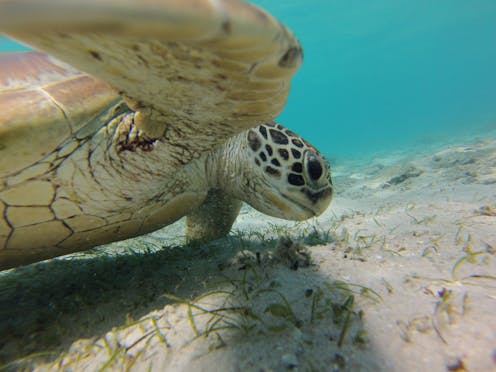
If you knew that there was zero percent chance of being eaten by a shark, would you swim more often? Rhetorical questions aside, the fear of being eaten has a profound influence on other animals too, and on the way they use marine environments.
Turtles, for example, fear being eaten by sharks and this restricts the movement and behaviour of entire populations. But when the fear of being eaten dissipates, we see that turtles eat more, breed more, and go wherever they please.
It might sound like turtle paradise, but in an article published today in Nature Climate Change we show that loss of ocean predators can have serious, cascading effects on oceanic carbon storage and, by extension, climate change.
Cascading effects
For a long time we’ve known that changes to the structure of food webs – particularly due to loss of top predators – can alter ecosystem function. This happens most notably in situations where loss of predators at the top of the food chain releases organisms lower in the food chain from top-down regulatory control. For instance, the loss of a predator may allow numbers of its prey to increase, which may eat more of their prey, and so on. This is known as “trophic downgrading”.
With the loss of some 90% of the ocean’s top predators, trophic downgrading has become all too common. This upsets ecosystems, but in our article we also report its effects on the capacity of the oceans to trap and store carbon.
This can occur in multiple ecosystems, with the most striking examples in the coastal zone. This is where the majority of the ocean’s carbon is stored, within seagrass, saltmarsh and mangrove ecosystems – commonly known as “blue carbon” ecosystems.
Blue carbon ecosystems capture and store carbon 40 times faster than tropical rainforests (such as the Amazon) and can store the carbon for thousands of years. This makes them one of the most effective carbon sinks on the planet. Despite occupying less that 1% of the sea floor, it is estimated that coastal blue carbon ecosystems sequester more than half the ocean’s carbon.
The carbon that blue carbon ecosystems store is bound within the bodies of plants and within the ground. When predators such as sharks and other large fish are removed from blue carbon ecosystems, resulting increases in plant-eating organisms can destroy the capacity of blue carbon habitats to sequester carbon.
For example, in seagrass meadows of Bermuda and Indonesia, less predation on herbivores has resulted in spectacular losses of vegetation, with removal of 90–100% of the above-ground vegetation.
Stop killing predators
Such losses of vegetation can also destabilise carbon that has been buried and accumulated over millions of years. For example, a 1.5-square-kilometre die-off of saltmarsh in Cape Cod, Massachusetts, caused by recreational overharvesting of predatory fish and crabs, freed around 248,000 tonnes of below-ground carbon.
If only 1% of the global area of blue carbon ecosystems were affected by trophic cascades as in the latter example, this could result in around 460 million tonnes of CO2 being released annually, which is equivalent to the annual CO2 emissions of around 97 million cars, or just a bit less than Australia’s current annual greenhouse gas emissions.
So what can be done? Stronger conservation efforts and modification of fishing regulations can help restore marine predator populations, and thereby help maintain the important indirect role that predators play in climate change mitigation.
It’s about restoring balance so that we have, for example, healthy and natural numbers of both sea turtles and sharks. Policy and management need to reflect this important realisation as a matter of urgency.
More than 100 million sharks may be killed in fisheries each year, but if we can grant these predators great protection they may just help to save us in return.
Peter Macreadie receives funding from the Australian Research Council.
Rod Connolly receives funding from Australian Research Council.
Trisha B Atwood receives funding from CSIRO Marine and Coastal Carbon Biogeochemistry Cluster.
Euan Ritchie and Graeme Hays do not work for, consult, own shares in or receive funding from any company or organisation that would benefit from this article, and have disclosed no relevant affiliations beyond their academic appointment.
* This article was originally published at The Conversation
HELP STOP THE SPREAD OF FAKE NEWS!
SHARE our articles and like our Facebook page and follow us on Twitter!




0 Comments